‘A layer cake of environmental pollution’: Greenpoint struggles with rezoning 18 years on
April 20, 2023, 6 a.m.
New York City's vision of replacing a contaminated industrial shoreline with a community of luxury towers remains incomplete — and may now be threatened by sea level rise.
It's been 18 years since New York City rezoned Greenpoint's waterfront, and local residents are still waiting for the green spaces they were promised. The city’s vision of replacing a contaminated industrial shoreline with a new community of luxury apartment towers remains incomplete — and may now be threatened by sea level rise.
Greenpoint is one of the most polluted neighborhoods in the nation. It is bordered by the East River and Newtown Creek, and centuries of industry — including oil refineries, shipyards and factories — have tainted its coastlines and poisoned the soil underneath many of its streets. The neighborhood is also home to two federal Superfund sites – the Meeker Avenue Plume and Newtown Creek — as well as the Greenpoint oil spill, one of the largest oil spills in U.S. history.
In 2005, the New York City Council passed a massive rezoning across 175 blocks of Greenpoint and nearby Williamsburg, which was spearheaded by then-Mayor Michael Bloomberg. The rezoning was intended to spur residential growth along the East River by allowing real estate developers to remediate polluted industrial sites and replace them with enormous luxury apartment towers. Bonuses were given to towers that included affordable housing. The rezoning was described by The New York Times as rivaling “the ambition and scope of the creation of Battery Park City,” and included a pledge to open up 50 acres of public space.
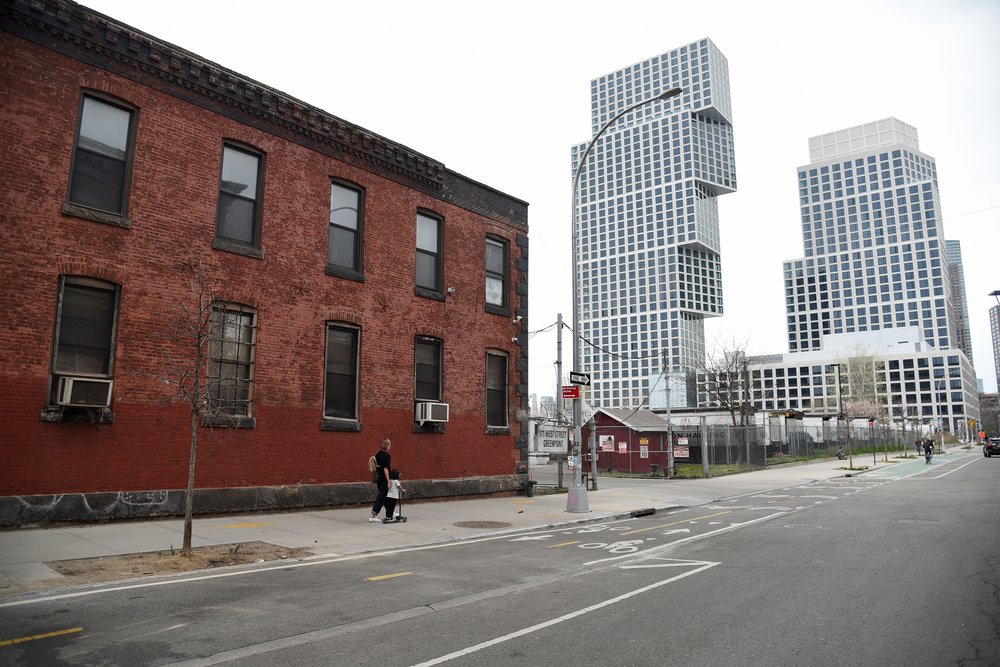
After nearly two decades of construction, Greenpoint's waterfront is still a fragmented work in progress, with no end in sight. Soaring towers are bordered by truck parking lots, and incomplete parks look out onto toxic brownfields, which are designated vacant sites where pollution remains unresolved.
Several new green spaces and towers have opened, but many more are still under construction or have yet to break ground. The public pathway along 1.6 miles of the neighborhood’s East River waterfront is far from complete. Elected leaders said Greenpoint was underequipped to handle these towers and thousands of new residents.
“It’s hard to know how the neighborhood is going to absorb more people,” said state Assemblymember Emily Gallagher, who represents the 50th District that includes Greenpoint and Williamsburg.
Comparing the speed of development in Williamsburg and Greenpoint after the rezoning illustrates Gallagher's point. Greenpoint’s rezoning is expected to bring tens of thousands of new residents to the neighborhood, but between 2010 and 2020, just 2,203 people moved into the neighborhood, according to a 2023 report from the NYC Department of City Planning. By contrast, in nearby Williamsburg, where new housing units were more rapidly built after the 2005 rezoning, there was a net migration of 11,166 people into the neighborhood.
Back in 2005, Greenpoint's waterfront was mostly populated by one-story warehouses, lumber yards, parking lots and outdated municipal facilities, including a 52-foot high sewage sludge tank. Along its quiet dead-end streets, intrepid locals would sneak past chain link fences to sunbathe on broken piers. Newtown Barge Playground, which back then was the waterfront's only public park, was a neglected stretch of asphalt surrounded by high fences at the time.
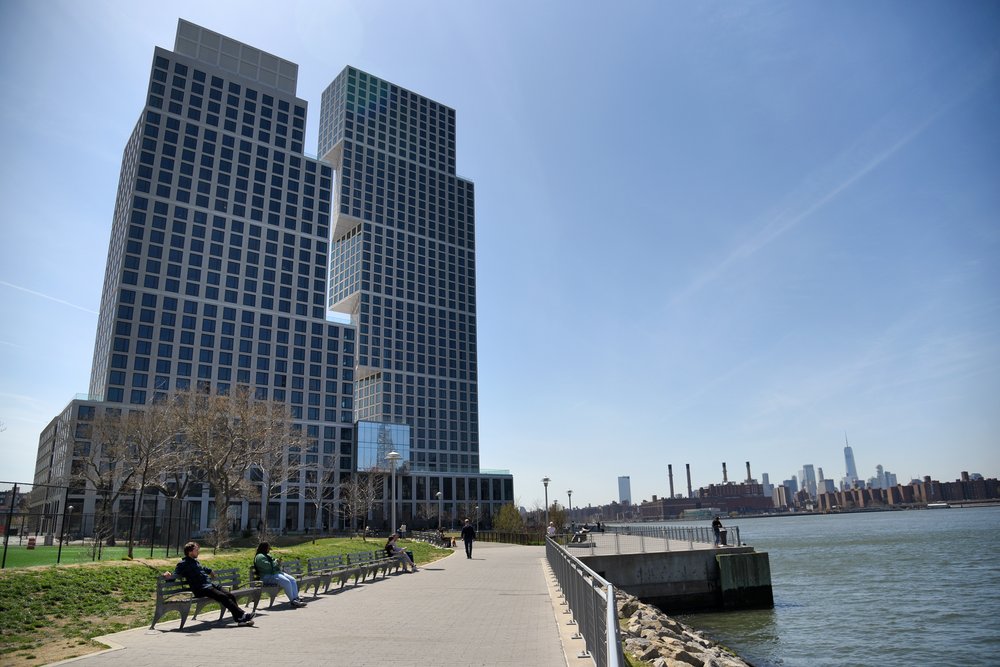
Today, many of these same streets have been radically transformed by 40-story residential towers and block-long construction sites. Along the stretch of coast between the Newtown Creek and Bushwick Inlet, at least 13 waterfront towers have been completed, or are now nearing completion, and at least five other sites are being prepped for new buildings.
The largest development project is Greenpoint Landing, located at the mouth of the Newtown Creek. This new 22-acre community will eventually include 11 towers with 5,500 residential units.
It broke ground on its first affordable housing building in 2014, its first market rate apartment tower opened in 2018, and several other towers have since been completed. Bordering them are a new 1,500-foot waterfront esplanade and a revamped Newtown Barge Playground, which give the public access to a coastline that was fenced off for generations.
Cleaning a toxic legacy
The delays in Greenpoint’s redevelopment can be partially attributed to the Great Recession, which began in 2007, Hurricane Sandy in 2012 and COVID-19’s arrival in 2020. The neighborhood’s complicated toxic legacy has also greatly impeded the construction of new parks and towers.
As part of the city’s initial rezoning proposal, the Department of City Planning completed an in-depth environmental impact study of the entire rezoning area, including an assessment of potential hazardous materials at each of the 340 sites within its proposed footprint in Greenpoint and Williamsburg. The study identified hundreds of sources of contamination, including oil spills, landfills, leaking tanks, and chemical and petroleum storage facilities.
“We have a layer cake of environmental pollution that is at a level I think most people can’t even comprehend. We have a bevy of brownfields, we have state Superfund sites, then we have federal Superfund sites, then we have places that are just kind of abandoned or not well cared for, that need cleaning up,” said Gallagher, who became involved in environmental and social justice activism in Greenpoint after moving to the neighborhood in 2006. “So, we have pollution above us and below us at every level.”
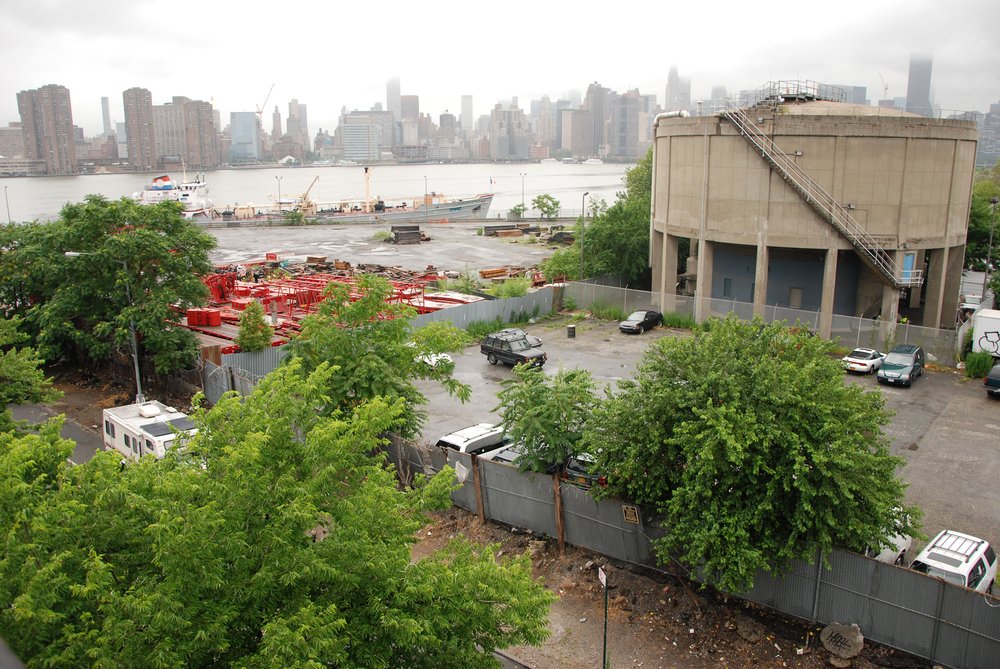
All 340 sites in the proposed rezoning area were found to have concerning environmental conditions, and were recommended for a special (E) designation, which means developers need to investigate and address any hazardous materials onsite, before they can obtain a building permit for redevelopment.
As a result, several notoriously polluted locations in Greenpoint are being cleaned up. The Greenpoint sludge tank was demolished in 2014 and a new 40-story tower with 378 apartments will soon rise in its place. The NuHart Plastic Manufacturing facility, a state-designated Superfund site, was demolished in 2022, and its toxic underground chemical plumes are now being remediated. It will be replaced by two residential buildings with 471 apartments, which could be completed by 2025.
“The big irony is that because of how our system is set up, with such lack of accountability for corporations, the only people that can afford to really undo the damages are other corporations who have something to profit from,” said Gallagher.
Will the waterfront parks arrive before sea level rise?
One of the major community benefits promised in the 2005 rezoning was that new public spaces would be built to accommodate the expected influx of thousands of new residents. In Greenpoint, the city laid out plans for several new parks and an uninterrupted public pathway from the Newtown Creek down to Bushwick Inlet as part of a 2005 Waterfront Access Plan. This process is now being guided by an Open Space Master Plan.
“The idea is to have a continuous waterfront, where you should be able to walk or bike from the top of the creek all the way down to the end of Williamsburg,” said Katie Denny Horowitz, the executive director of the North Brooklyn Parks Alliance. “Significant progress is happening every year, but when you are talking about an actual contiguous green space … it’s a long way away, because of the complications of some individual parcels.”
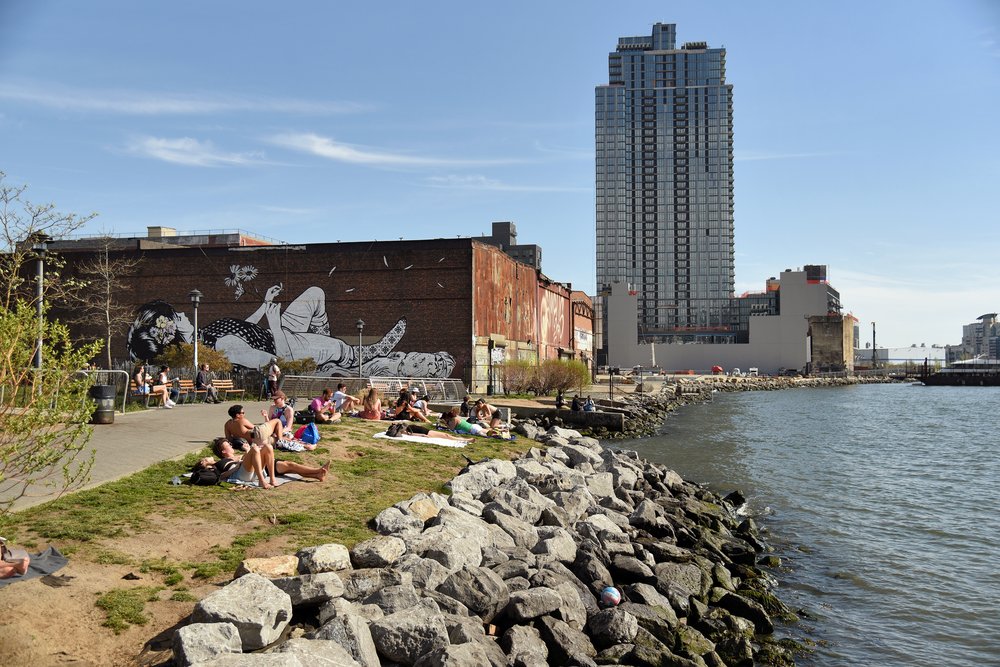
Besides the Greenpoint Landing Esplanade and Newtown Barge Playground, the only other parks to open on Greenpoint’s waterfront are the tiny 1.6 acre WNYC Transmitter Park, which opened in 2012, and an even smaller playground and esplanade built as part of The Greenpoint, a 40-story tower on India Street.
The rezoning requires that any privately owned properties that are redeveloped must create an accessible shoreline green space. However, several property owners have not made plans to redevelop their sites, leaving these new parks and public spaces hemmed in by industrial properties with private waterfronts that are fenced off and tantalizingly out of reach.
“They are complicated sites in part because of the area’s industrial history,” said Denny, who has lived in Greenpoint for 20 years, and worked on open space and parks issues in the community for 15 years. “You have to do some digging to find out who or what was responsible for whatever contamination might be, and then who is going to clean it up, before it becomes public space. Because you can’t invite the public into contaminated land.”
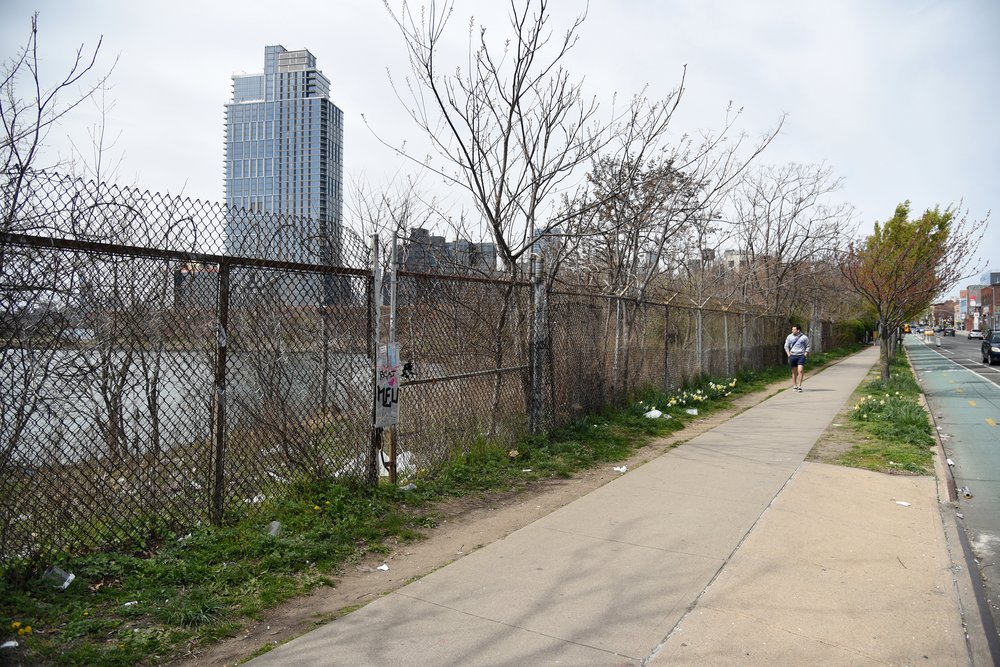
As part of the rezoning, the city promised to build a new 28-acre park around Bushwick Inlet, a heavily polluted cove on the border of Greenpoint and Williamsburg, and to create the 2.8 acre Box Street Park at the north side of the rezoning footprint. But neither of these parks is complete despite years of activism and protests by the community, as well as the efforts of numerous advocacy groups and elected officials.
“It’s quite infuriating,” said Steve Chesler, the vice president of the board at Friends of Bushwick Inlet Park, a volunteer organization that has been fighting for the park to be completed. “Eighteen years and counting, and Box Street Park hasn’t even broken ground. It’s supposed to soon.”
The first section of Bushwick Inlet Park opened in Williamsburg in 2010, and a second section opened in Greenpoint in 2022 at 50 Kent Ave., a state Superfund site that was previously a manufactured gas plant and sanitation garage. The inlet itself remains fenced off by razor wire, its crumbling shoreline littered with broken piers and debris. By Chesler’s estimation, it may not be open to the public for another three years.
The park should be done already. It was supposed to take 10 years, in 2005.
Steve Chesler, Friends of Bushwick Inlet Park.
“Bushwick Inlet Park has about 6 acres open and about 21 left to get developed,” he said. “The park should be done already. It was supposed to take 10 years, in 2005. It just violates the public trust.”
City officials have cited the acquisition of land for the park as a major source of delays. It has so far taken 11 years and cost the city over $350 million. This price tag included paying $160 million for an 11-acre site housing a fire-damaged warehouse, and $53 million for an 8 acre site containing the enormous oil tanks at the Bayside Fuel Oil Depot, which were then demolished in 2019. The remediation of that site, and an adjoining parcel that is home to a former document storage facility, will take many more years.
“There is a long haul ahead for that whole process,” said Chesler, who has lived in Greenpoint for 21 years and is also the chair of the local community board's environmental protection committee. “But we are not going to relent.”
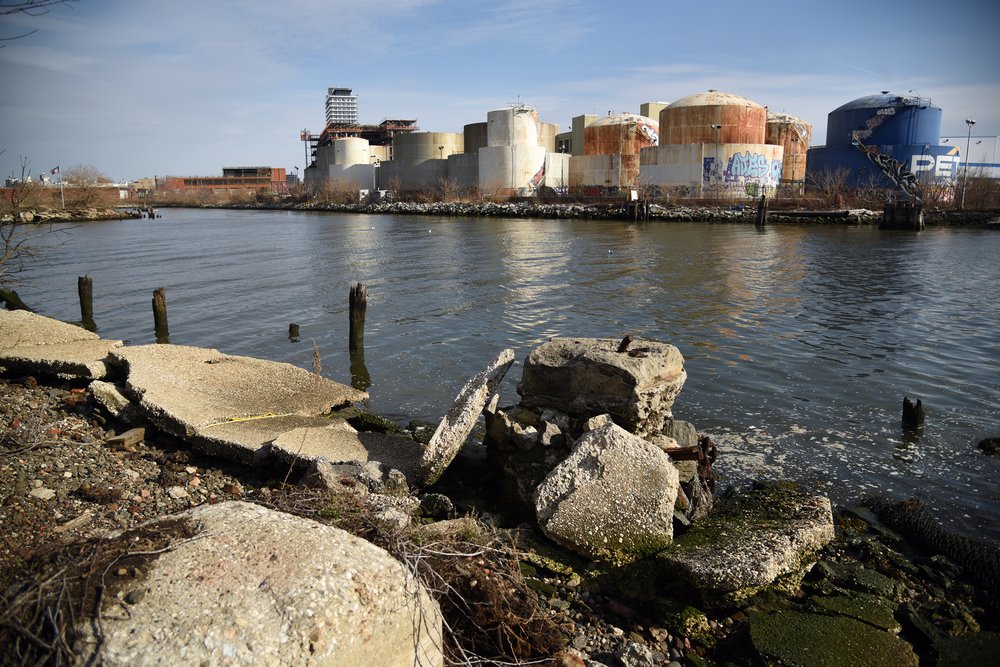
As the towers rise along Greenpoint’s waterfront, sea levels have also continued to rise. The most recent report from the New York City Panel on Climate Change anticipates that by 2050, New York will see between 0.67 feet and 2.5 feet of sea level rise, which could dramatically increase the risk of flooding for Brooklyn’s coastal residents. Greenpoint’s entire waterfront already sits in Flood Zone AE, which is at high risk of flooding, according to the Department of City Planning’s Flood Hazard Map.
Greenpoint’s waterfront was flooded in 2012 by Hurricane Sandy’s storm surge, which pushed up the East River and into the Newtown Creek. To protect the neighborhood against future storm surges, the US Army Corps of Engineers has proposed building a storm surge gate at the mouth of the creek, as part of the NY & NJ Harbor & Tributaries Focus Area Feasibility Study.
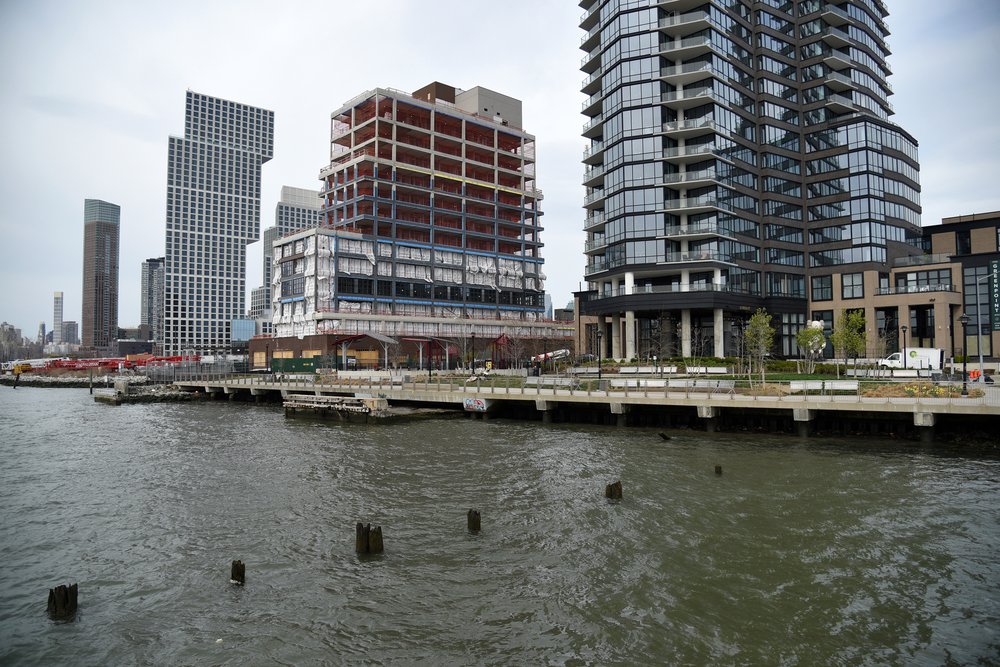
The proposed gate would be constructed in the middle of the new public esplanade at Greenpoint Landing, and would be linked to almost a mile of barriers on land, including a 15-foot-high concrete seawall that would cut across the waterfronts of several new residential towers.
The North Brooklyn Parks Alliance has publicly voiced its concerns about potential impacts of the Army Corps plans, which could cut off the newly acquired access to the water, undoing decades of activism, planning and development. They also recognize that without any form of protection, the thousands of new residents moving into the rezoned waterfront will be facing a huge risk of flooding from storms and rising seas.
“That’s like the twist ending of this whole story, is that Greenpoint just ends up being underwater in 20 years, and nobody lives here,” said Gallagher, who believes that some residents will need to be relocated away from the neighborhood’s flood zones. “But managed retreat doesn’t make anybody a profit, and we put the profit at the forefront of everything here, and that’s going to ultimately be our undoing.”
In recognition of Earth Day, WNYC will broadcast a special edition of "All Things Considered" live from WNYC Transmitter Park in Greenpoint, exploring the neighborhood’s industrial history and the steps the city is taking to remediate pollution amid a large-scale rezoning effort and a population boom. We’ll be at WNYC Transmitter Park on Friday, April 21, starting at 4 p.m. You can also listen live here on Gothamist and on your radio at 93.9 FM.
What’s behind an uptick in whale deaths on NJ, NY shores? Experts, advocates are divided. NYC is behind in meeting its solar energy goals. Can it catch up? How climate change is helping the Yankees and Mets hit home runs